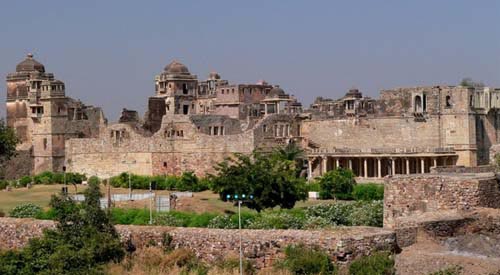Rana Kumbha Palace

Information on Rana Kumbha Palace (Chittorgarh, Rajasthan) - History & Architecture
Rana Kumbha Palace is located inside the Chittorgrah Fort Village, Chittorgarh District, Rajasthan State, India. This fort is a unique masterpiece of Rajputana architecture. It is well know place of largest self immolation by queen and her followers, twice in this fort.
Rana Kumbha Palace Architecture
Rana Kumbha Palace is a huge structure, built inside the Chitorgarh fort area. This fort itself is a giant barrier to protect this palace from external aggressions. The entire edifice is built of sandstones, which are not of equal proportions. This fort will be looking as if it was ruined long back, but it is not as such. The fill up of irregular size of these stones make them look like a ruined one. But the fort and the palace are still standing on this unparalleled stones. It has nearly 4 stories, were a central court yard is present which can occupy a 700 members. A special queen house is built here. There are many underground cellars, for storage purpose. The distinguished part is the large pound built here, for palace utility purposes. There is also a large water reservoir built inside this fort area, which is no were seen in other parts of Rajasthan. This reservoir was the main water supply for the Chittorgarh Village. There are two high raised towers built here to mark the victory of Chitorgarh and the other tower is the mark of fame of the Rajputanas in this regions. The palace is raised high from a large basement which is in the shape of a rectangle. There are many open doors and windows found here. It is believed that these open doors and windows provide a smooth flow of air throughout its buildings. The stone carving works on the victory and fame towers are awesome. There are also carving activities on the tower domes, arch doors and open windows. Another notifying feature is this palace looks like a step tower, when viewed from different angles. There are many small temples built inside which are uniquely carved on these stones Another important features is that there are very less use of bonding past or tartar used in construction of the entire fort and palaces. It is a joint strength of the stone placed in a dynamic mode. That why this palace is still standing great in the history of time.
Rana Kumbha Palace History
Rana Kumbha Palace was built on a ruined palace built in the 734 AD. The new palace was built here by the great Maharaja Kumbha from the period of 1433 AD to the 1468 AD. He was known for his art and cultural patronages in Rajasthan's Mewar Dynasty. This palace was in the attack of Ala-ud-din Khilji of Khilji Dynasty of Northern part of India, in the year 1303 AD. This attack and capturing of Maharana made the Maharani Padmini and a set of women's in this palace committed Jauhar a custom in Rajasthan, were the war mans women's self immolate when their husbands are in war, this is done to safe guard their honor and not to come in trap of the enemies and get harassed by them. It is said that this kind of Jauhar were committed twice and more than 1000 women's were charred here by fire. This is also said in the history of this fort that their soul s is still haunting this palace. The great devotee of Lord Krishna named Meera came to its palace temple and worshiped in this place is well known in the history of this fort a palace.
Rana Kumbha Palace Tourism Importance
Rana Kumbha Palace is believed to be a breath taking and most haunted palace to see in Rajasthan in the yester years. This is a protected monument and a tourist place for fort and history buffs. Its historical importance is quite known and popular and more of all, the historical incidents that once took inside the walls of the Palace, makes it even more popular and historical importance. Visiting this colossal fort is truly worth relishing, but as it is considered to be haunted and protected, it is advised to take proper learning process and understanding, before visiting this colossal forts, that stands today with same glory and artistic value though today it seems to be ruined one.
- Andaman Nicobar Monuments
- Andhra Pradesh Monuments
- Assam Monuments
- Bihar Monuments
- Chhattisgarh Monuments
- New Delhi Monuments
- Goa Monuments
- Gujarat Monuments
- Haryana Monuments
- Himachal Pradesh Monuments
- Jammu and Kashmir Monuments
- Karnataka Monuments
- Kerala Monuments
- Madhya Pradesh Monuments
- Maharashtra Monuments
- Odisha Monuments
- Punjab Monuments
- Rajasthan Monuments
- Tamil Nadu Monuments
- Telangana Monuments
- Uttar Pradesh Monuments
- West Bengal Monuments